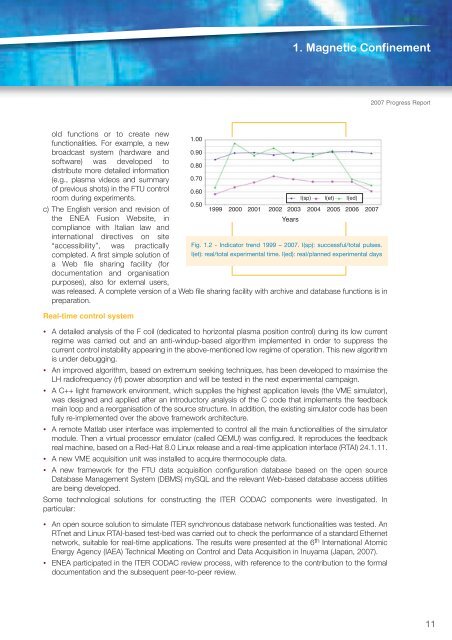Fusion Programme - ENEA - Fusione
Fusion Programme - ENEA - Fusione
Fusion Programme - ENEA - Fusione
- No tags were found...
Create successful ePaper yourself
Turn your PDF publications into a flip-book with our unique Google optimized e-Paper software.
1. Magnetic Confinement2007 Progress Reportold functions or to create newfunctionalities. For example, a newbroadcast system (hardware andsoftware) was developed todistribute more detailed information(e.g., plasma videos and summary1.000.900.800.70of previous shots) in the FTU control 0.60room during experiments.l(sp) l(et) l(ed)c) The English version and revision of0.50 1999 2000 2001 2002 2003 2004 2005 2006 2007the <strong>ENEA</strong> <strong>Fusion</strong> Website, inYearscompliance with Italian law andinternational directives on site“accessibility”, was practically Fig. 1.2 - Indicator trend 1999 – 2007. I(sp): successful/total pulses.completed. A first simple solution of I(et): real/total experimental time. I(ed): real/planned experimental daysa Web file sharing facility (fordocumentation and organisationpurposes), also for external users,was released. A complete version of a Web file sharing facility with archive and database functions is inpreparation.Real-time control system• A detailed analysis of the F coil (dedicated to horizontal plasma position control) during its low currentregime was carried out and an anti-windup-based algorithm implemented in order to suppress thecurrent control instability appearing in the above-mentioned low regime of operation. This new algorithmis under debugging.• An improved algorithm, based on extremum seeking techniques, has been developed to maximise theLH radiofrequency (rf) power absorption and will be tested in the next experimental campaign.• A C++ light framework environment, which supplies the highest application levels (the VME simulator),was designed and applied after an introductory analysis of the C code that implements the feedbackmain loop and a reorganisation of the source structure. In addition, the existing simulator code has beenfully re-implemented over the above framework architecture.• A remote Matlab user interface was implemented to control all the main functionalities of the simulatormodule. Then a virtual processor emulator (called QEMU) was configured. It reproduces the feedbackreal machine, based on a Red-Hat 8.0 Linux release and a real-time application interface (RTAI) 24.1.11.• A new VME acquisition unit was installed to acquire thermocouple data.• A new framework for the FTU data acquisition configuration database based on the open sourceDatabase Management System (DBMS) mySQL and the relevant Web-based database access utilitiesare being developed.Some technological solutions for constructing the ITER CODAC components were investigated. Inparticular:• An open source solution to simulate ITER synchronous database network functionalities was tested. AnRTnet and Linux RTAI-based test-bed was carried out to check the performance of a standard Ethernetnetwork, suitable for real-time applications. The results were presented at the 6 th International AtomicEnergy Agency (IAEA) Technical Meeting on Control and Data Acquisition in Inuyama (Japan, 2007).• <strong>ENEA</strong> participated in the ITER CODAC review process, with reference to the contribution to the formaldocumentation and the subsequent peer-to-peer review.11













